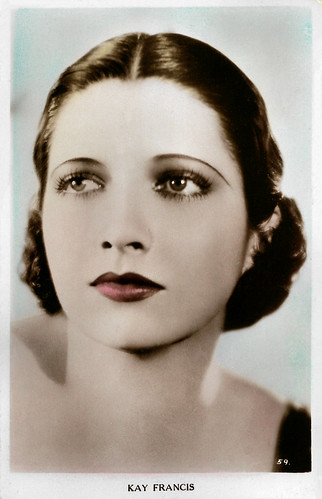
British postcard by Art Photo, no. 59.
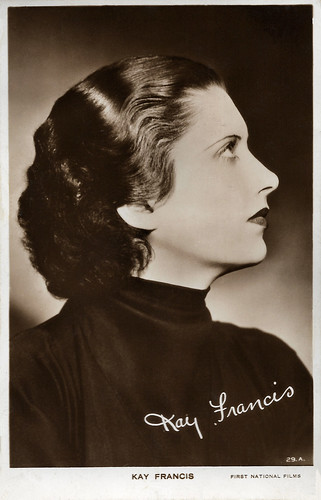
British postcard by Milton, no. 29.A. Photo: First National Films.
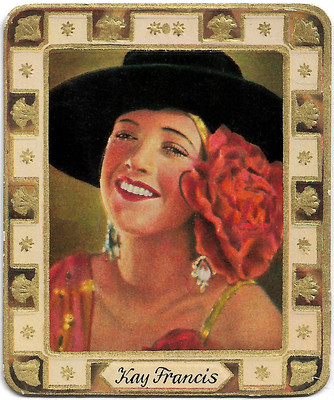
German collectors card in the Moderne Schönheitsgalerie by Ross Verlag, series 2, no 267 of 300. Photo: Paramount. Kay Francis as Carmen in the episode 'The Toreador' in Paramount on Parade (Edmund Goulding a.o., 1930). The card was a supplement with 'Edelzigarette Kurmark'.

French postcard by Europe, no. 643. Photo: Films Paramount.
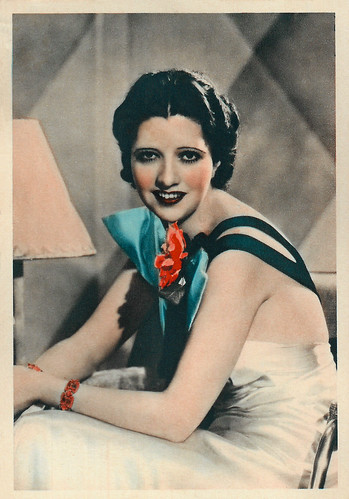
British postcard by De Reszke, no. 20 of 24. Caption: On leaving school, where she was prominent in athletes, Kay Francis became a secretary. Decided upon a stage career: first role was of the "player queen" in a modernised version of 'Hamlet'. Spent a season with a stock company and finally arrived on Broadway. Her first picture was Gentlemen of the Press and the most recent Mandalay and British Agent.
A jazz-era woman with a bob line
Kay Francis was born Katherine Edwina Gibbs in 1905 in Oklahoma City, Oklahoma. However, the year of her birth has been speculated about, with dates anywhere from 1899 to 1908. She was the daughter of actress Katherine Clinton and businessman Joseph Gibbs.
Her father left the family when Francis was four years old. The family travelled from town to town in search of work in the theatre. During this period, Francis grew up in poverty and her mother had to work as a prostitute. After attending some Catholic schools, Francis was trained to become a secretary in 1920. She sold real estate and arranged extravagant parties for wealthy socialites.
Following her marriage in 1922 to James Dwight Francis, the son of a moneyed family, Kay adopted the surname Francis. Kay returned to New York, where she tried to break into the theatre. Her first acting job was as the Player Queen in a modernised version of 'Hamlet' (1925), credited as 'Katharine Francis'. Francis acquired an image of a sexually liberated flapper: a jazz-era woman with a bob line. She played Marjorie Grey in the melodrama 'Crime' (1927) alongside Sylvia Sidney and appeared in the Ring Lardner play 'Elmer the Great' (1928), starring Walter Huston as Elmer Kane.
Huston was so pleased with Francis' performance that he advised her to take a screen test for the film Gentlemen of the Press (Millard Webb, 1929) in which he starred. She was given the role of a femme fatale, making a powerful film debut. Paramount subsequently offered her a contract (1929-1931). In Hollywood, Kay Francis achieved her greatest success between 1930 and 1936. First, she had a bit in the first Marx Brothers outing, The Cocoanuts (Robert Florey, Joseph Santley, 1929). Then she graduated to playing sophisticated seductresses opposite stars like Ronald Colman.
In 1930, she first appeared alongside William Powell in Street of Chance (John Cromwell, 1930). Because the press was so enthusiastic about the chemistry between the two, they eventually acted together in six films. She also appeared in the Lubitsch comedy Trouble in Paradise (Ernst Lubitsch, 1932), though being unhappy about being billed below Miriam Hopkins. One of her best early films was the comedy-drama One Way Passage (Tay Garnett, 1932), in which Kay portrayed a gravely-ill baroness opposite William Powell's gentleman burglar. This doomed romance, interlaced with witty dialogue, was described by a reviewer as 'spilled cocktail and love at first sight'.
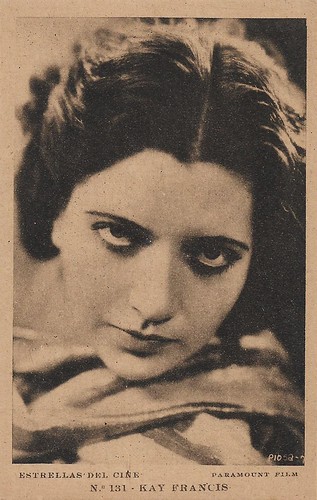
Spanish postcard in the Estrellas del cine series by Editorial Grafica, Barcelona, no. 131. Photo: Paramount Films.

British postcard in the Film Weekly series. Photo: United Artists. Ronald Colman and Kay Francis in Cynara (King Vidor, 1932), a romantic drama film about a British lawyer (Colman) who pays a heavy price for an affair. Francis plays his wife.
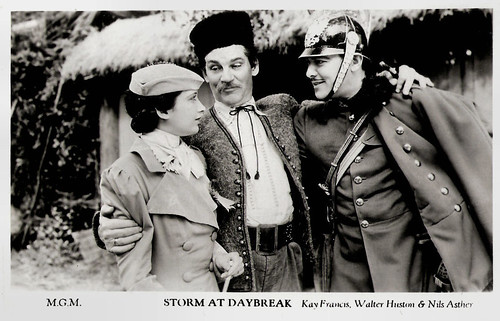
British postcard in the Filmshots Series by Film Weekly. Photo: MGM. Kay Francis, Walter Huston and Nils Asther in Storm at Daybreak (Richard Boleslawski, 1933).

British postcard in the Filmshots Series by Film Weekly. Photo: MGM. Nils Asther, Kay Francis and Walter Huston in Storm at Daybreak (Richard Boleslawski, 1933).
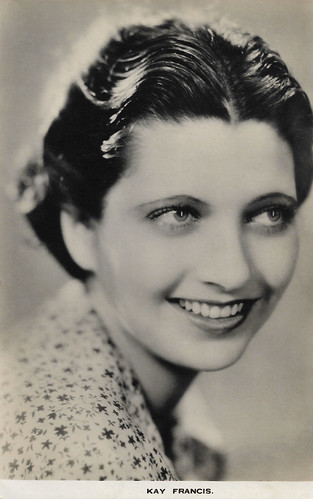
British postcard in the Film Weekly Series, London.
Hollywood's best-dressed woman
Paramount, at the time well-stocked with female stars but experiencing financial problems, decided to let Kay Francis move to Warner Brothers. The studio promised her a higher salary and star status and started promoting her.
Kay became the number one female star at the Warner Brothers studio, becoming the highest-paid American film actress in those years. By 1935, she earned a yearly salary of $115,000. She soon acquired a reputation as Hollywood's 'best-dressed woman', wearing the most glamorous gowns designed by great studio costumers like Orry-Kelly, Travis Banton and Adrian. Female audiences, in particular, often flocked to see Kay Francis's pictures simply to appreciate her sumptuous wardrobe.
'America's glamour girl' had major hits with I Found Stella Parish (Mervyn LeRoy, 1935) and Confession (Joe May, 1937), both excellent money-spinners for the studio. But in 1938 she was declared box-office poison in an advertisement in The Hollywood Reporter by the Independent Theatre Owners Association. She was first reduced to supporting parts and eventually, she had to work on Poverty Row.
During the mid-1940s, Kay co-produced several B-movies as vehicles for herself at Monogram, then made a brief return to stage work. Her most memorable role was in 'State of the Union', a play that became a huge success on Broadway and later toured the country. She acted in summer stock and also made several appearances on television and radio before retiring permanently in 1953.
Kay Francis spent the remainder of her life in New York and in her estate near Falmouth, Cape Cod. In 1961, she was diagnosed with cancer. She broke off her relationship with a younger lover because she did not want him to feel obliged to look after her. In 1967, her health deteriorated sharply and she hardly appeared in public. She died a year later, at the age of 63. She left some of her estate (in excess of one million dollars) to an organisation training guide dogs for the blind, Seeing Eye Inc. She was married and divorced three times. Her husbands were James Dwight Francis (1922-1925), William Gaston (1925-1927), and actor Kenneth MacKenna (1931-1934).
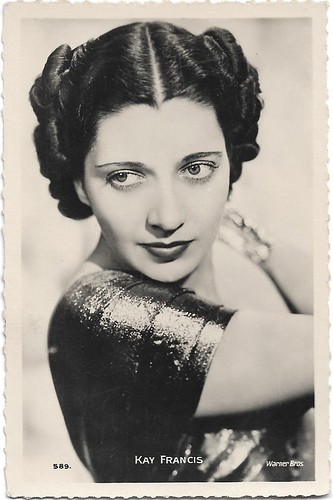
French postcard by Editions E.C., Paris, no. 289. Photo: Warner Bros.
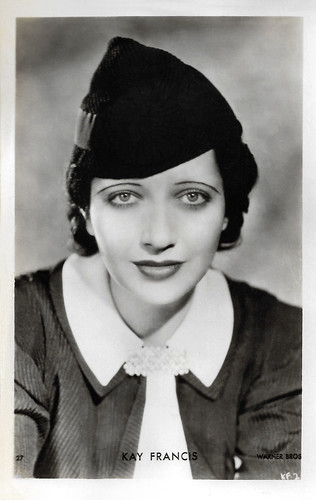
French postcard, no. 27. Photo: Warner Bros.

Dutch postcard, no. 659, mailed in 1936. Photo: Warner Bros.
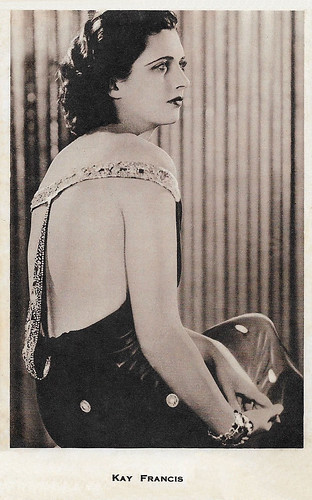
Vintage card.

Italian postcard by Rizzoli & C. Milano, 1938. Photo: First National.
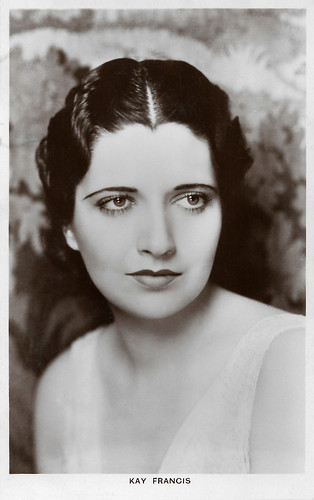
British postcard in the Picturegoer Series, London, no. 457a.

British postcard in the Picturegoer Series, London, no. 457d. Photo: Universal.
Sources: Wikipedia (Dutch) and IMDb.
No comments:
Post a Comment